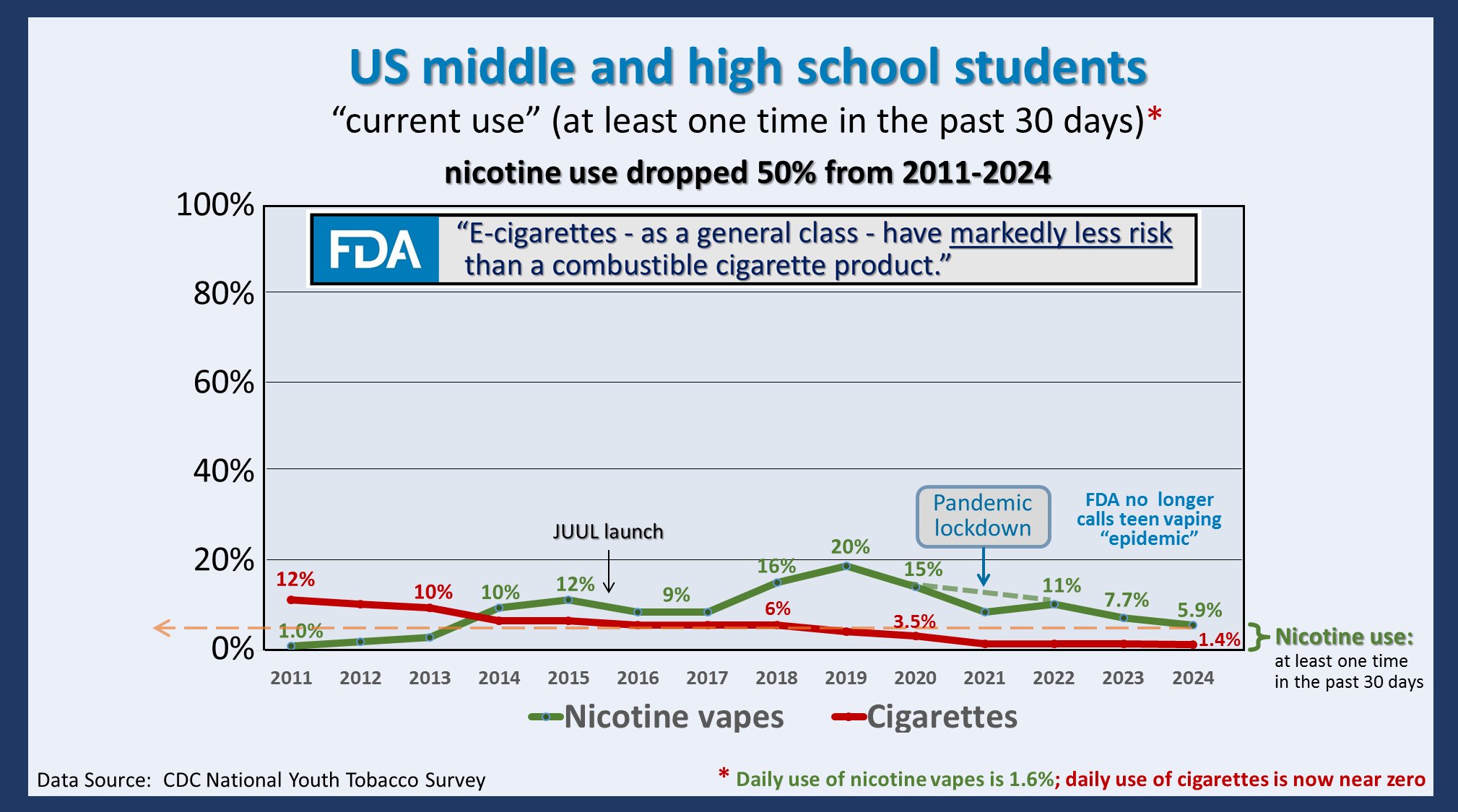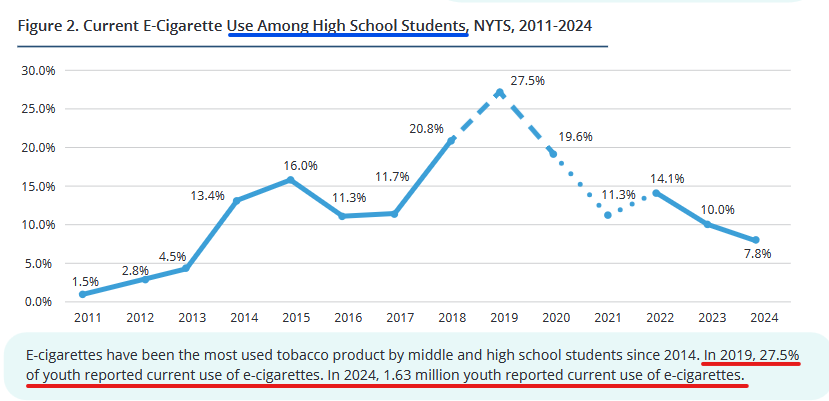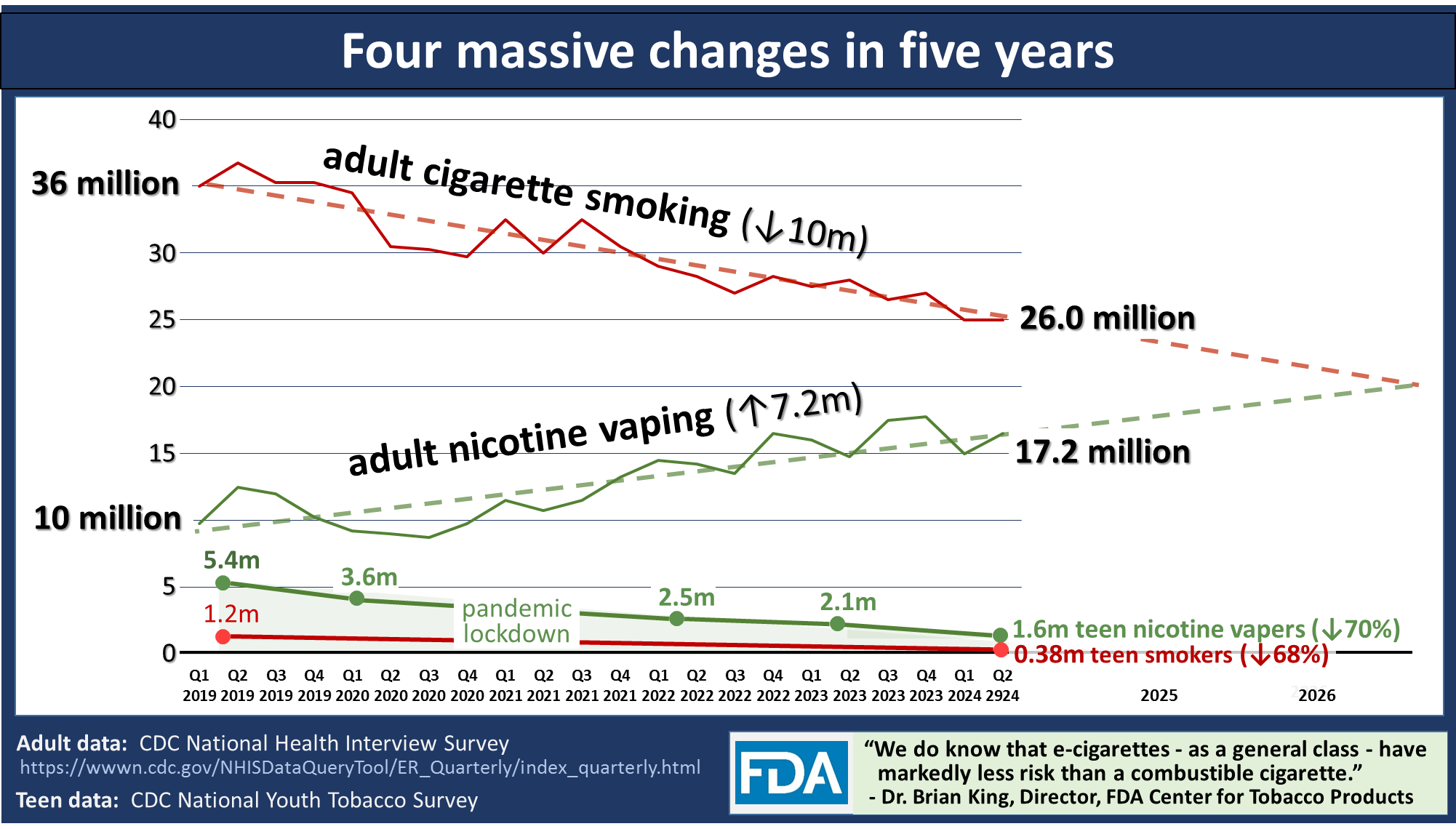Over the course of my career as a science journalist I’ve learned an important but disheartening lesson: experts are allowed to mislead the public about certain health topics. One of the most egregious cases is nicotine vaping. This life-extending habit has enabled millions of smokers to give up cigarettes forever, and for that reason it should be considered an important medical innovation.
But that is not how many leading figures in the public health establishment view vaping. Consider this recently released report from the Truth Initiative, arguably the most influential anti-nicotine group in the US. The report, published on November 21, documented a 47 percent increase in e-cigarette unit sales at U.S. retail outlets from 2019 through 2023, 80 percent of those sales coming from flavored vapor products.
The correct conclusion to draw from these results (as we’ll see) is that adult smokers are switching from cigarettes to nicotine vapor products en masse, a remarkable public health victory since vaping is far less harmful than smoking. But that’s not the conclusion Truth took from its results.
Numbers change, the conclusion doesn't
I mentioned above that public health researchers regularly mislead Americans about vaping. Here’s a textbook example from the summary Truth put in the press release for its report:
“The rise in e-cigarette sales, particularly those with youth-appealing flavors and graphics, is deeply concerning ..."
Notice the careful phrasing here. Flavored vapes are kid friendly and they’re popular in the US. Truth is implying that teen vaping is widespread because of flavored products, a dishonest conclusion the press dutifully reported. Compare this deceptive language to the results from the CDC’s and FDA's most recent National Youth Tobacco Survey (NYTS), depicted in the graph below:

Credit: Dr. Charles Gardner
The survey showed that "current use" of vapes and cigarettes among all teens–defined as any use in the last 30 days–have been steadily falling for years. Current vaping sits at 5.9 percent and current smoking is even lower at 1.4 percent. That means America’s youth are increasingly disinterested in vaping, and they’re certainly not using it as a “gateway” to smoking. Truth reported (p 11) that "youth e-cigarette use has declined since its peak in 2019" but didn't explain how substantially it has declined since then.
Neurobiologist Charles Gardner has helpfully supplied several other notable results from the NYTS data worth highlighting:
-
Daily teen vaping is just 1.6 percent
-
More than 94 percent of teens do not vape at all
-
Overall, teen vaping has dropped 70 percent since 2019
The Truth report excluded these figures, most likely because they are devastating to the group's subterfuge about "persistent nicotine dependence" among teens. [1]
There were several other oddities in Truth's presentation of the NYTS data. First, the report stated that "In 2019, 27.5% of youth reported current use of e-cigarettes. In 2024, 1.63 million youth reported current use of e-cigarettes." By comparing a percentage to a whole number, Truth further obscured the decline in youth vaping from 2019 to 2024. "Without knowing the denominator you have no idea how the percentage has changed," my colleague Dr. Chuck Dinerstein added. "Mixing metrics in the same two sentences is either intentionally misleading or ignorance of how to properly display and provide data."

Credit: Truth Initiative
The second problem is that current use of e-cigarettes among teens (all middle- and high-school students) in 2019 was just under 20 percent. Truth mislabeled current use among high-school students in 2019 (27.5 percent) as current use among middle- and high-school students, then compared that figure to current use among middle- and high-school students in 2024, which is 5.9 percent (or 1.63 million students). It's a completely nonsensical comparison.
Finally, the top line of Truth's graph is 30 percent, which makes teen vaping look much higher overall since 2011. Compare Truth's graph to the one supplied by Gardner above, which goes up to 100 percent, and you'll see what I mean.
Why the sleight of hand?
The Truth Initiative is desperately trying to obfuscate the fact that nicotine vaping is an enormously popular substitute for smoking among adults. We know this for a few reasons. First, adult vaping has increased significantly as adult smoking has fallen (graph below). Industry sales data confirms the correlation: declines in cigarette sales mirror inclines in vape sales. If you have an allergy to industry-supplied numbers, here’s a 2018 survey in which adult smokers reported that “they found vaping pleasurable and enjoyable—being more than a substitute but actually preferred, over time, to tobacco smoking.”

Credit: Dr. Charles Gardner
The National Bureau of Economic Research also provided some helpful numbers in 2022 that underscore the point: analysis of Nielsen Retail Scanner Data from 2011 to 2019 showed “that a $1.00 increase in the [vaping] tax … increases cigarette sales by 10%.” In an ironic twist, the Truth Initiative made the very same observation in a 2019 report on tobacco taxes:
“[A] comparatively lower tax rate makes those products that help smokers switch completely to significantly less harmful products more accessible, and increases incentives to quit the more expensive, and most harmful combustible products.”
Conclusion
Let’s put all these data points together. Teen vaping and smoking have dropped precipitously. Adult vaping is increasing while adult smoking is falling. Flavored vapes are the most popular options on the market, and tax hikes on these products encourage adults to return to cigarettes. Conclusion: vaping helps adults quit smoking without enticing youth to use nicotine.
Why would the Truth Initiative, an organization whose mission is “to prevent youth and young adult nicotine addiction,” so eagerly minimize the unprecedented decline in youth vaping? That’s a story for another day.
[1] Truth is well aware of the record declines in youth smoking and vaping, at least when taking credit for them. The group's "Our Mission" page boasts that its "nationally recognized public education campaigns ... have helped drive down youth smoking from 23% in 2000 to under 2% today and reduced youth e-cigarette use to its lowest level in a decade."




